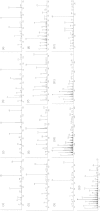A rapid method for profiling of volatile and semi-volatile phytohormones using methyl chloroformate derivatisation and GC-MS
- PMID: 26491427
- PMCID: PMC4605965
- DOI: 10.1007/s11306-015-0837-0
A rapid method for profiling of volatile and semi-volatile phytohormones using methyl chloroformate derivatisation and GC-MS
Abstract
Phytohormones are central components of complex signalling networks in plants. The interplay between these metabolites, which include abscisic acid (ABA), auxin (IAA), ethylene, jasmonic acid (JA) and salicylic acid (SA), regulate plant growth and development and modulate responses to biotic and abiotic stress. Few methods of phytohormone profiling can adequately quantify a large range of plant hormones simultaneously and without the requirement for laborious or highly specialised extraction protocols. Here we describe the development and validation of a phytohormone profiling protocol, based on methyl-chloroformate derivatisation of the plant metabolites and analysis by gas chromatography/mass spectrometry (GC-MS). We describe the analysis of 11 metabolites, either plant phytohormones or intermediates of phytohormone metabolism; ABA, azelaic acid, IAA, JA and SA, and the phytohormone precursors 1-aminocyclopropane 1-carboxylic acid, benzoic acid, cinnamic acid, 13-epi-12-oxophytodienoic acid (13-epi-OPDA), linoleic acid and linolenic acid, and validate the isolation from foliar tissue of the model legume Medicago truncatula. The preparation is insensitive to the presence of water, facilitating measurement of the volatile metabolites. Quantitation was linear over four orders of magnitude, and the limits of detection between two and 10 ng/mL for all measured metabolites using a single quadrupole GC-MS.
Keywords: Abscisic acid; Azelaic acid; Ethylene; Idole-3-acetic acid; Jasmonic acid; Medicago truncatula; Plant defence; Salicylic acid.
Conflict of interest statement
Conflict of interest
The authors declare no conflict of interest.
Ethical statement
No ethical requirements were needed.
Figures


References
-
- Anderson JP, Lichtenzveig J, Gleason C, Oliver RP, Singh KB. The B-3 ethylene response factor MtERF1-1 mediates resistance to a subset of root pathogens in Medicago truncatula without adversely affecting symbiosis with rhizobia. Plant Physiology. 2010;154:861–873. doi: 10.1104/pp.110.163949. - DOI - PMC - PubMed
LinkOut - more resources
Full Text Sources
Other Literature Sources
Miscellaneous
